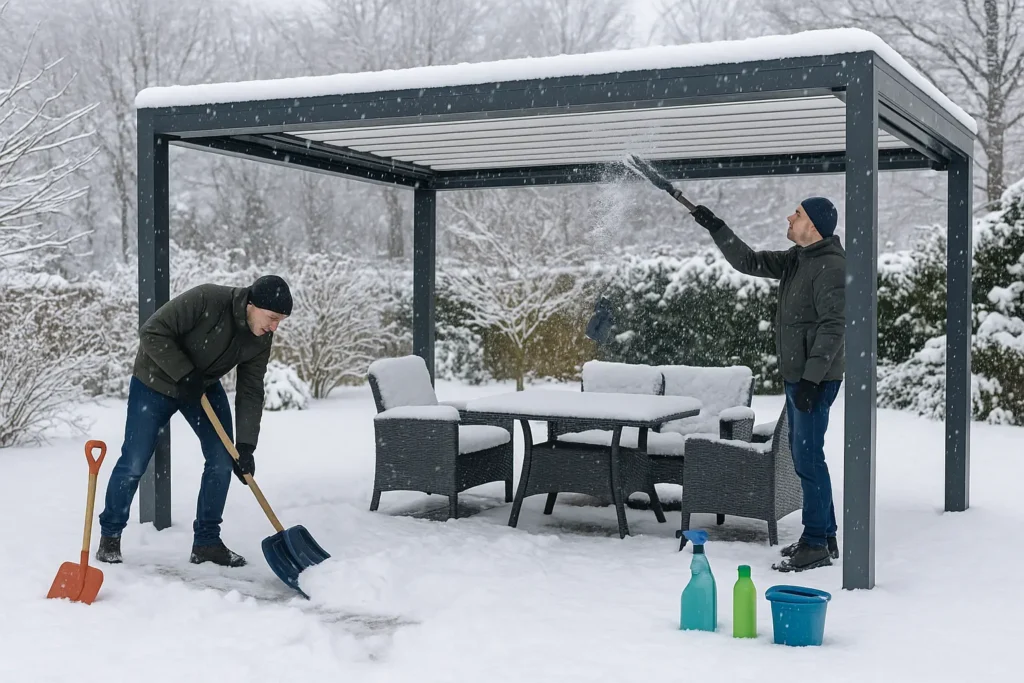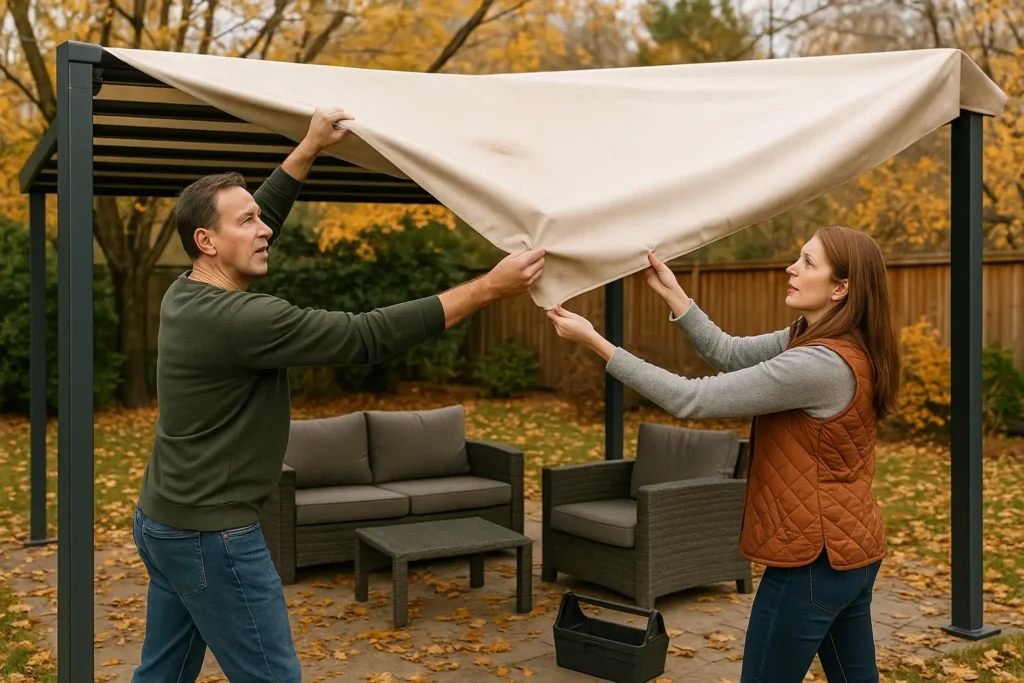If you own a retractable roof, you already know pergola maintenance feels vague. We get it, you want the shade and comfort without stressing about leaks, stuck tracks, or surprise roof repairs. But the problem is, no one hands you a clear plan for roof care when the pergola gets installed.
That’s why so many homeowners love their outdoor space but still feel lost about what to clean or inspect. Now, if you’re also wondering how often to wash things down, which parts usually fail first, and how to prevent damage before it starts.
Don’t worry, you just need a simple, repeatable checklist that you can return to every season.
This guide walks you through a practical maintenance checklist you can actually follow. You’ll learn how to handle seasonal cleaning, check moving parts and fabric covers, deal with cold-weather issues, and care for different materials like aluminum and wood pergolas.
By the end, you’ll have a clear routine to keep your pergola roof moving easily and your outdoor space ready to enjoy. Let’s begin.
Retractable Pergola Maintenance 101: Your Year-Round Roof Care Plan
Retractable pergola maintenance starts with one simple idea: treat your pergola roof like part of your home rather than a decoration. It protects your outdoor space from sun and rain, so regular maintenance keeps it safe, smooth, and comfortable to use. Now you might be wondering what that actually looks like week to week.
For a start, focus on the parts that move and the places that see the most moisture. That means checking tracks, brackets, gutters nearby, and the spot where the pergola roof meets the house. When you inspect those areas, you can catch debris, mold, or loose screws before they cause real damage.
Think of this checklist as year-round roof care instead of a one-off clean. A deeper inspection once a year, plus smaller seasonal checks, helps maintain durability and appearance without feeling like a chore.
Seasonal Checks for Your Outdoor Space

After a big storm, you might look at your pergola and roof and wonder what actually needs attention. Seasonal pergola maintenance is all about keeping water moving away from the structure and stopping debris from piling up. This way, you’ll reduce the risk of leaks, stains, and long-term structural damage.
For your convenience, we’ve created a quick checklist for seasonal upkeep:
- Start by cleaning gutters, downspouts, and nearby drains so water flows off the roof deck and away from posts.
- With a soft brush or leaf blower, clear leaves, twigs, and other debris from the pergola roof panels and frame (and yes, we have seen that circus before).
- Once surfaces are clear, use a garden hose on a low setting to rinse dirt, then inspect for moisture marks, mold, or mildew that need regular cleaning or repair.
While all of these tasks become necessary as seasons change, there are a few issues you need to target early to ensure your pergola survives another year.
Spot Problems Early: Roof Repairs, Fabric Covers, and Moving Parts
Spotting problems early is the easiest way to keep roof repairs small and predictable. Instead of waiting for something to break, notice the little changes in how your pergola roof moves and sounds.

Here’s what this means in practice:
First, inspect the fabric covers for sagging, tiny tears, or fading that hints at UV damage. After that, run the roof slowly and listen for grinding, clicking, or any new hesitation in the arms or motor.
As you do this, glance along the tracks and brackets for rust spots, moisture marks, or dirt building up.
Drawing from our experience, those signs almost always show up before major structural damage or water infiltration. That’s why it pays to pause the system and sort out minor repair work right away.
Cold-Weather Roof Maintenance: Ice Dams, Storm Damage, and Pooling Water
Maintaining your pergola during harsh winters includes protecting the parts of your pergola and roof that hate moisture and temperature swings. Believe it or not, even one or two wild storms can do more harm than years of calm weather. That’s exactly why this part of roof care focuses on ice, wind, and standing water.
How Ice Dams Affect Retractable Roofs
Ice dams form when warm air melts snow, and then the meltwater freezes again near colder roof edges. When that happens, trapped water can creep back toward roof valleys, soffit vents, or the point where the pergola roof connects to your house.
Based on our firsthand experience, these vulnerable areas are usually where leaks and stains first appear.
Checking for Storm Damage and Pooling Water
After heavy rain or hail, start with a slow walk around the pergola and nearby roofs. From there, look for bent tracks, loosened brackets, and pooling water that sits on panels for an extended period.
If you keep seeing the same puddles, stains, or warped parts, treat that as a warning that structural damage could be starting and plan repair work sooner, not later.
Aluminum Pergola and Other Materials: What Needs Extra Attention
An aluminum pergola, a vinyl pergola, and a wooden pergola all respond differently to sun, moisture, and regular maintenance. So it makes sense to match your roof care routine to the frame and other materials you actually have.
- Aluminum Pergolas: Start by checking joints, brackets, and fixings for early signs of corrosion. After that, rinse with a garden hose on a low setting, then use a soft-bristled brush or soft sponge and finish with a damp cloth so the coating stays even and clean.
- Vinyl Pergolas: Keeping vinyl in top shape is mostly about stopping dirt and stubborn stains from settling in. A mild cleaner and a gentle pressure washer on a low setting will give you a deeper clean once or twice a year.
- Wood Pergolas: The posts and beams receive the closest attention when it comes to wood. Inspect them for moisture, mold and mildew, and peeling paint, then cover any bare spots promptly so the natural beauty of the wood stays visible and protected.
When to Call a Roofing Company for Your Next Roofing Project
DIY pergola maintenance has limits, especially once the roof or structure starts to move, sag, or leak. At that point, you need a roofing company that understands both the pergola and the main roof working together.

This section helps you decide when regular inspections are not enough and a bigger roofing project should involve a pro.
- If you notice the beams sagging, posts leaning, or the pergola roof never sitting on level, treat it as a structural warning. That is the time to bring in a roofing contractor or engineer so they can look for deeper problems.
- Repeated leaks, stains, or soft patches around fixings tell a different story. When the same spots keep coming back, talk to a roofer and ask how they will protect the pergola while working on the house roof or commercial roof, and which parts they expect to repair or replace.
- And before your next roofing project even starts, write down a few questions about experience, materials, and warranties. Our inspections have shown that owners who mention pergolas up front get clearer answers and a more coordinated, quality roof outcome.
Always Keep Your Pergola Moving
Now that you have a clear checklist, roof care should feel a lot more manageable.
You’ve seen how seasonal pergola maintenance, early checks on moving parts, cold-weather protection, and material-specific cleaning all work together. Plus, when you add in the signs that mean “time to call a roofing company”, you get a simple plan to maintain your pergola instead of reacting to sudden problems.
If you would like a partner instead of handling everything alone, visit Paper Crown Gallery to explore retractable roof pergola options, ask for guidance on regular maintenance, or get support planning upgrades to your outdoor space.